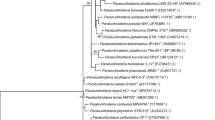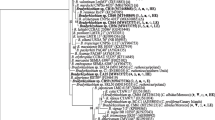Abstract
The phylogeny of symbiotic genes of Robinia pseudoacacia (black locust) rhizobia derived from Poland and Japan was studied by comparative sequence analysis of nodA, nodC, nodH, and nifH loci. In phylogenetic trees, black locust symbionts formed a branch of their own suggesting that the spread and maintenance of symbiotic genes within Robinia pseudoacacia rhizobia occurred through vertical transmission. There was 99–100% sequence similarity for nodA genes of Robinia pseudoacacia nodulators, 97–98% for nodC, and 97–100% for nodH and nifH loci. A considerable sequence conservation of sym genes shows that the symbiotic apparatus of Robinia pseudoacacia rhizobia might have evolved under strong host plant constraints. In the nodA and nodC gene phylograms, Robinia pseudoacacia rhizobia grouped with Phaseolus sp. symbionts, although they were not closely related to our isolates based on 16S rRNA genes, and with Mesorhizobium amorphae. nifH gene phylogeny of our isolates followed the evolutionary history of 16S rDNA and Robinia pseudoacacia rhizobia grouped with Mesorhizobium genus species. Nodulation assays revealed that Robinia pseudoacacia rhizobia effectively nodulated their native host and also Amorpha fruticosa and Amorpha californica resulting in a significant enhancement of plant growth. The black locust root nodules are shown to be of indeterminate type.







Similar content being viewed by others
References
Aguilar OM, Riva O, Peltzer E (2004) Analysis of Rhizobium etli and of its symbiosis wild Phaseolus vulgaris supports coevolution in centers of host diversification. Proc Natl Acad Sci USA 101:13548–13553
Bena G, Lyet A, Huguet T, Olivieri I (2005) Medicago-Sinorhizobium symbiotic specificity evolution and the geographic expansion of Medicago. J Evol Biol 18:1547–1558
Corby HDL (1988) Types of rhizobial nodules and their distribution among the Leguminosae. Kirkia 13:53–123
Debelle F, Moulin L, Mangin B, Dénarie J, Boivin C (2001) Nod genes and Nod signals and the evolution of the rhizobium legume symbiosis. Acta Biochem Polon 48:359–365
Downie JA (1998) Functions of rhizobial nodulation genes. In: Spaink HP, Kondorosi A, Hooykaas PJJ (eds) The Rhizobiaceae. Kluwer, Dordrecht, pp 387–402
González V, Bustos P, Ramírez-Romero MA, Medrano-Soto A, Hernández-González I, Hernández-Lelis JC, Quintero V, Moreno-Hagelsieb G, Girard L, Rodríguez O, Flores M, Cevallos MA, Collado-Vides J, Romero D, Dávilla G (2003) The mosaic structure of the symbiotic plasmid of Rhizobium etli CFN42 and ist relation to other symbiotic genome compartments. Genome Biol 4:R36
Gőttfert M, Rőthlisberger S, Kűndig Ch, Beck Ch, Marty R, Hennecke H (2001) Potential symbiosis-specific genes uncovered by sequencing a 410-kilobase DNA region of the Bradyrhiozbium japonicum chromosome. J Bacteriol 183:1405–1412
Han TX, Wang ET, Han LL, Chen WF, Sui XH, Chen WX (2008) Molecular diversity and phylogeny of rhizobia associated with wild legumes native to Xinjiang, China. Syst Appl Microbiol 31:287–301
Haukka K, Lindström K, Young JPW (1998) Three phylogenetic groups of nodA and nifH genes in Sinorhizobium and Mesorhizobium isolated from leguminous trees growing in Africa and Latin America. Appl Environ Microbiol 64:419–426
Hennecke H, Kaluza B, Thőny M, Fuhrmann M, Ludwig W, Stackebrandt E (1985) Concurrent evolution of nitrogenase genes and 16S rRNA in Rhizobium species and other nitrogen fixing bacteria. Arch Microbiol 142:342–348
Kalita M, Stępkowski T, Łotocka B, Małek W (2006) Phylogeny of nodulation genes and symbiotic properties of Genista tinctoria bradyrhizobia. Arch Microbiol 186:87–97
Laeremans T, Coolsaet N, Verreth C, Snoeck C, Hellings N, Vanderleyden J, Martínez-Romero E (1997) Functional redundancy of genes for sulphate activation enzyme in Rhizobium sp. BR816. Microbiol 143:3933–3942
Laguerre G, Mavingui P, Allard M-R, Charnay M-P, Luovier P, Mazurier S-I, Rigottier-Gois L, Marger N (1996) Typing of rhizobia by PCR DNA fingerprinting and PCR-restriction fragment length polymorphism analysis of chromosomal and symbiotic gene regions: application to Rhizobium leguminosarum and its different biovars. Appl Environ Microbiol 62:2029–2036
Laguerre G, Nour SM, Macheret V, Sanjuan J, Drouin P, Amarger N (2001) Classification of rhizobia based on nodC and nifH analysis reveals a close phylogenetic relationship among Phaseolus vulgaris symbionts. Microbiol 147:981–993
Lerouge P, Roche P, Faucher C, Maillet F, Trucher G, Promé J-C, Dénarie J (1990) Symbiotic host-specificity of Rhizobium meliloti is determined by a sulfated and acylated glucosamine oligosaccharide signal. Nature 344:781–784
Łotocka B, Kopcińska J, Golinowski W (1997) Morphogenesis of root nodules in white clover. I. Effective root nodules induced by the wild type of Rhizobium leguminosarum biovar. trifolii. Acta Soc Bot Pol 66:273–292
Martínez E, Romero D, Palacios R (1990) The Rhizobium genome. Crit Rev Plant Sci 9:17–29
Mierzwa B, Wdowiak-Wróbel S, Małek W (2009) Phenotypic, genomic and phylogenetic characteristics of rhizobia isolated from root nodules of Robinia pseudoacacia (black locust) growing in Poland and Japan. Arch Microbiol 191:697–710
Nandasena KG, O’Hara GW, Tiwari RP, Sezmis E, Howieson JG (2007) In situ lateral transfer of symbiosis islands results in rapid evolution of diverse competitive strains of mesorhizobia suboptimal in symbiotic nitrogen fixation on the pasture legume Biserrula pelecinus L. Environ Microbiol 9:2496–2511
Nicholas KB, Nicholas HBJ (1997) GeneDoc. Pittsburgh Supercomputing Center, Pittsburgh, Pa
Page RD (1996) TREE VIEW: an application to display phylogenetic trees on personal computers. Comput Appl Biosci 12:357–358
Perret X, Broughton WJ (1998) Rapid identification of Rhizobium strains by targeted PCR fingerprinting. Plant Soil 204:457–462
Perret X, Staehelin C, Broughton WJ (2000) Molecular basis of symbiotic promiscuity. Mol Biol Rev 64:180–201
Posada D, Crondall KA (1998) Modeltest: testing the model of DNA substitution. Bioinformatics 49:817–818
Poupot R, Martínez-Romero E, Promé J-C (1993) Nodulation factors from Rhizobium tropici are sulfated or non-sulfated chitopentasaccharides containing an N-methyl-N-acylglucosamine terminus. Biochemistry 32:10430–10435
Pueppke SG, Broughton WJ (1999) Rhizobium sp. strain NGR234 and Rhizobium fredii USDA257 share exceptional broad, nested host ranges. Mol Plant-Microbe Interact 12:293–318
Renier A, Jourand P, Rapior S, Poinsot V, Sy A, Dreyfus B, Moulin L (2007) Symbiotic properties of Methylobacterium nodulans ORS 2060T: a classic process for an atypical symbiont. Soil Biol Chem 40:1404–1412
Sprent JI (2001) Nodulation in legumes. Royal Botanic Garden, Kew
Sullivan JT, Ronson CW (1998) Evolution of rhizobia by acquisition of a 500-kb symbiosis island that integrates into a phe-tRNA gene. Proc Natl Acad Sci USA 95:5145–5149
Sullivan JT, Patrick HN, Lowther WL, Scott DB, Ronson CW (1995) Nodulating strains of Rhizobium loti arise through chromosomal symbiotic gene transfer in the environment. Proc Natl Acad Sci USA 92:8985–8989
Suominen L, Roos Ch, Lortet G, Paulin L, Lindstrőm K (2001) Identification and structure of the Rhizobium galegae common nodulation genes: evidence for horizontal gene transfer. Mol Biol Evol 18:907–916
Thompson JD, Gibson TJ, Plewniak F, Jeanmougin F, Higgins DG (1997) The CLUSTAL X windows interface: flexible strategies for multiple sequence alignment aided by quality analysis tools. Nucleic Acids Res 25:4876–4882
Timmers ACJ, Soupéne E, Auriac MC, de Billy F, Vasse J, Boistard P, Truchet G (2000) Saprophytic intracellular rhizobia in alfalfa nodules. MPMI 13:1204–1213
Turner GL, Gibson AH (1980) Measurement of nitrogen fixation by indirect means. In: Bergerson FJ (ed) Methods for evaluating biological nitrogen fixation. Wiley, New York, pp 111–138
Ulrich A, Zaspel I (2000) Phylogenetic diversity of rhizobial strains nodulating Robinia pseudoacacia (L.). Microbiol 143:2997–3005
Vasse J, de Billy F, Camut S, Truchet G (1990) Correlation between ultrastructural differentiation of bacteroids and nitrogen fixation in alfalfa nodules. J Bacteriol 172:4295–4306
Vinuesa P, León-Barrios M, Silva C, Willems A, Jarabo-Lorenzo A, Pérez-Galdona R, Werner D, Martínez-Romero E (2005a) Bradyrhizobium canariense sp. nov., an acid-tolerant endosymbiont that nodulates endemic genistoid legumes (Papilionoideae: Genisteae from the Canary islands, along with Bradyrhizobium japonicum bv. genistearum, Bradyrhizobium genospecies alpha and Bradyrhizobium genospecies beta. Int J Syst Evol Microbiol 55:569–575
Vinuesa P, Silva C, Werner D, Martínez-Romero E (2005b) Population genetics and phylogenetic inference in bacterial molecular systematics: the role of migration and recombination in Bradyrhizobium species cohesion and delineation. Mol Phylogen Evol 34:29–54
Wdowiak-Wróbel S, Małek W (2010) Following phylogenetic tracks of Astragalus cicer microsymbionts. Antonie van Leeuwenhoek 97:21–34
Wei G, Chen W, Zhu W, Chen Ch, Young JP, Bontemps C (2009) Invasive Robinia pseudoacacia in China is nodulated by Mesorhizobium and Sinorhizobium species that share similar nodulation genes with nativ American symbionts. FEMS Microbiol Ecol 68:320–328
Wernegreen JJ, Riley MA (1999) Comparison of the evolutionary dynamics of symbiotic and housekeeping loci: a case for the genetic coherence of rhizobial lineages. Mol Biol Evol 16:98–113
Xu Y, Murooka Y (1995) A large plasmid isolated from Rhizobium huakuii bv. renge that includes genes for both nodulation of Astragalus sinicus cv. Japan and nitrogen fixation. J Ferment Bioeng 80:276–279
Yang G-P, Debelle F, Savagnac A, Ferro M, Schiltz O, Maillet F, Prome D, Treilhou M, Vialas C, Lindstrőm K, Dénarie J, Promé J-C (1999) Structure of the Mesorhizobium huakuii and Rhizobium galegae Nod factors: a cluster of phylogenetically related legumes are nodulated by rhizobia producing alpha, b-unsaturated fatty acids. Mol Microbiol 34:227–237
Young JWP (1992) Phylogenetic classification of nitrogen-fixing organisms. In: Stacey G, Burris RH, Evans HJ (eds) Biological nitrogen fixation. Chapman and Hall, New York, pp 43–86
Young JWP, Haukka KE (1996) Diversity and phylogeny of rhizobia. New Phytol 133:87–94
Zhang YF, Wang ET, Tian CF, Wang FQ, Han LL, Chen WF, Chen WX (2008) Bradyrhizobium elkanii, Bradyrhizobium yuanmingense and Bradyrhizobium japonicum are the main rhizobia with Vigna unguiculata and Vigna radiata in the subtropical region of China. FEMS Microbiol Lett 285:146–154
Zou X, Li F, Chen H (1997) Characteristics of plasmids in Rhizobium huakuii. Curr Microbiol 35:215–220
Acknowledgments
This work was supported by the grant from Ministry of Science and Higher Education No N303 057 32/1922. We also thank Ewa Znojek for expert technical assistance in microscopic studies.
Author information
Authors and Affiliations
Corresponding author
Additional information
Communicated by Ursula Priefer.
An erratum to this article can be found at http://dx.doi.org/10.1007/s00203-010-0580-x
Rights and permissions
About this article
Cite this article
Mierzwa, B., Wdowiak-Wróbel, S., Kalita, M. et al. Insight into the evolutionary history of symbiotic genes of Robinia pseudoacacia rhizobia deriving from Poland and Japan. Arch Microbiol 192, 341–350 (2010). https://doi.org/10.1007/s00203-010-0561-0
Received:
Revised:
Accepted:
Published:
Issue Date:
DOI: https://doi.org/10.1007/s00203-010-0561-0




